Charts of the Week
Charts of the week from 29 May to 2 June 2023: consumer prices, value of fiscally verified invoices, trade in goods, turnover in trade and other charts
The year-on-year increase in consumer prices slowed further in May but was still high at 8.4%. Growth was mainly driven by service prices, while the growth of food prices slowed slightly. Year-on-year nominal growth in the value of fiscally verified invoices in the second half of May was slightly lower than before the April and May holidays. Trade in goods continued to decline in April, which we attribute to a decline or weakening of activity in Slovenia’s main trading partners. In the first quarter of this year, real turnover further increased quarter-on-quarter in most market services and was also higher year-on-year, with the exception of transportation and storage. Turnover in most trade segments was also lower year-on-year, with the exception of the sale of motor vehicles, where turnover was significantly higher year-on-year also in April, according to preliminary data. According to the survey data, the unemployment rate fell year-on-year in the first quarter of this year and the number of persons in employment also declined slightly.
Consumer prices, May 2023
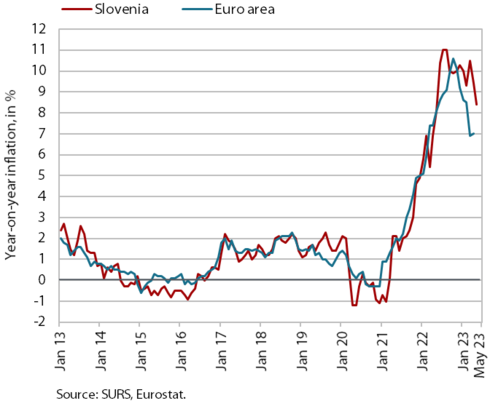
Year-on-year growth in consumer prices slowed further in May to 8.4%, the lowest level in twelve months. The biggest impact on moderation of year-on-year inflation came from lower year-on-year price increases in transport (0.5%) and housing, water, electricity, gas and other fuels (10.6%), which we estimate was mainly due to the higher base from last May, when energy prices had increased by almost 8% month-on-month. The year-on-year increase in food prices also slowed slightly in May (from 15.6% to 14.7%), contributing 2.3 p.p. to inflation. The year-on-year increase in durable goods prices continues to gradually weaken (4.9%). After rising in the previous two months, the increase in semi-durable goods prices also slowed in May (to 5.5%). This time the main contribution to inflation came from the prices of services (2.7 p.p.). Their growth strengthened further (from 7.9% to 8.3%). In our estimation, higher prices in recreation and culture and refuse collection contributed significantly to the higher growth.
Value of fiscally verified invoices, in nominal terms, 14–27 May 2023
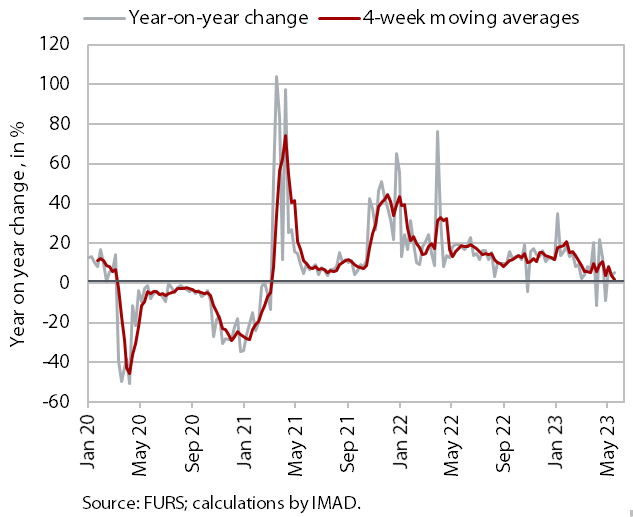
The nominal value of fiscally verified invoices between 14 and 27 May 2023 was 4% higher year-on-year, while it fell in real terms in May amid high price growth. After fluctuating in previous weeks, mainly influenced, especially in trade, by the timing of the Easter and Labour Day holidays, nominal year-on-year growth during the above-mentioned period was slightly lower than before the April and May holidays. Turnover in trade, which accounted for 78% of the total value of fiscally verified invoices, increased by 4% year-on-year. The strongest growth (14%) was recorded in the sale of motor vehicles. Turnover in wholesale and retail trade also increased (by 3% and 2% respectively). Nominal turnover growth in accommodation and food service activities and in certain creative, arts, entertainment, and sports services halved compared to the previous periods (overall growth was 5%), probably also due to the bad weather.
Trade in goods – in real terms, April 2023
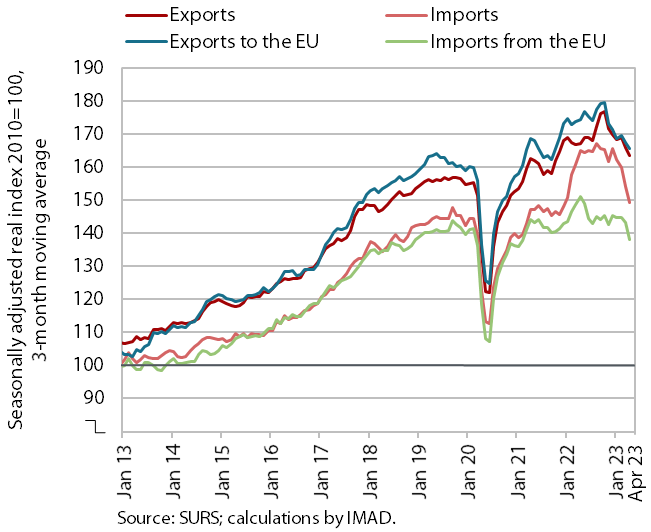
Trade in goods continued to decline in April, especially imports, and was significantly lower than a year ago. Real seasonally adjusted exports of goods fell by 2.9% in April (by 3.1% to EU Member States) and imports by 7.9% (by 5.9% from EU Member States). In recent months, exports of intermediate goods have continued to decline, especially to Slovenia’s main trading partners in the EU. Imports of consumer goods declined, while imports of intermediate goods fluctuated markedly from month to month. Compared to the same period last year, both exports and imports (also to and from EU Member States) were significantly lower in the first four months of this year (by 2.9% and 7.7% respectively). The decline or weakening of activity in Slovenia’s main trading partners and the continuing uncertainty in the international environment have weighed on the sentiment in export-oriented activities in recent months, with export orders falling further in May and export expectations remaining very low.
Turnover in trade, March–April 2023
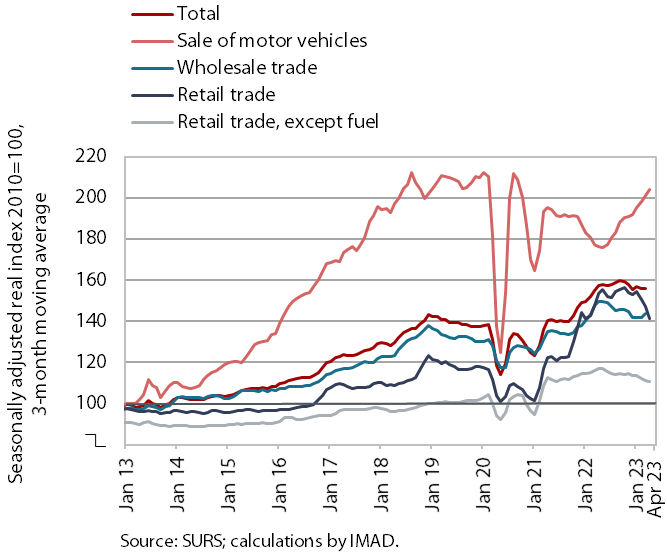
Turnover in the sale of motor vehicles was higher year-on-year in the first quarter and, according to preliminary data, also in April, while it was lower in wholesale and retail trade. Turnover in the sale of motor vehicles, which has been recovering in current terms since the second half of last year, increased by 15.7% year-on-year. In current terms (after a high increase in January and decline in February and March), turnover in wholesale trade also recovered, but was 3% lower than a year ago. Turnover in retail trade continued to decline and was also lower year-on-year (by 5.7% in the sale of food, beverages and tobacco and by 4% in the sale of non-food products). According to preliminary SURS data, turnover in April was also lower year-on-year in retail trade and significantly higher in the sale of motor vehicles.
Turnover in market services, March 2023
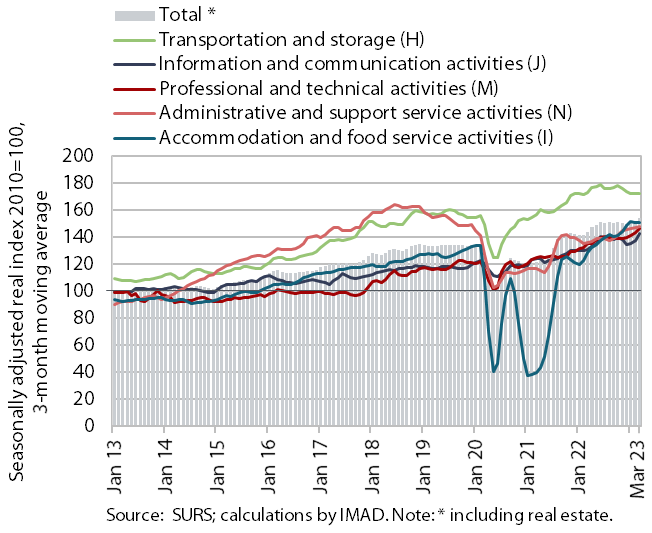
Real turnover in market services rose in the first quarter of this year. After a decline in the second half of last year, total turnover in market services increased by 3.2% in current terms compared to the fourth quarter of last year. Growth accelerated in professional and technical activities with continued strong sales growth in architectural and engineering services related to strong construction activity. Turnover growth in administrative and support service activities slowed despite a recovery of growth in employment services, while turnover in travel agencies exceeded pre-epidemic (Q1 2019) levels for the first time. Similarly, growth in accommodation and food service activities slowed after rising sharply in previous quarters. Turnover in information and communication activities increased again, this time mainly due to strong turnover growth in computer services. On the other hand, turnover in transportation and storage declined for the third quarter in a row, especially in warehousing and storage. In the first quarter of this year, total turnover was 6.7% higher in real terms year-on-year. It was also higher in most market service activities, with the exception of transportation and storage. Only turnover in administrative and support service activities and employment agencies was still below pre-epidemic (Q1 2019) levels, in the latter by 29%.
Active and inactive population, Q1 2023
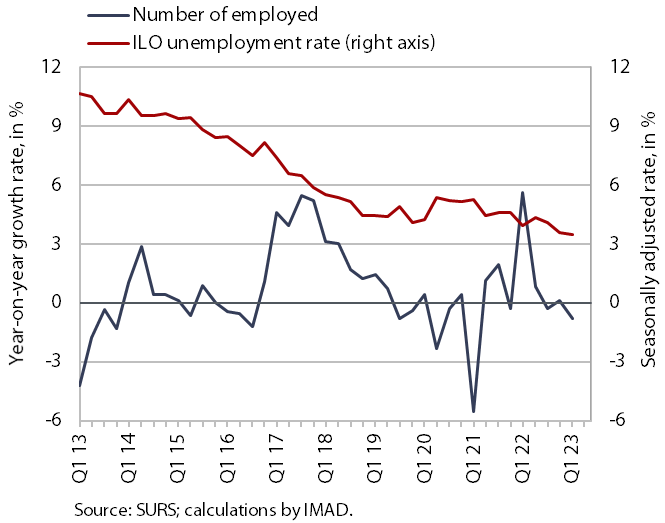
According to the survey data, unemployment fell year-on-year in the first quarter of this year and the number of persons in employment also declined. According to original data, 38 thousand persons were unemployed, which is 13.6% less than in the same period last year. The survey unemployment rate (3.8%) fell by 0.5 p.p. year-on-year. According to the survey data, the slowdown in economic activity also led to a slight decline in the number of persons in employment in the first quarter, when the volume of student work in particular was lower year-on-year.
